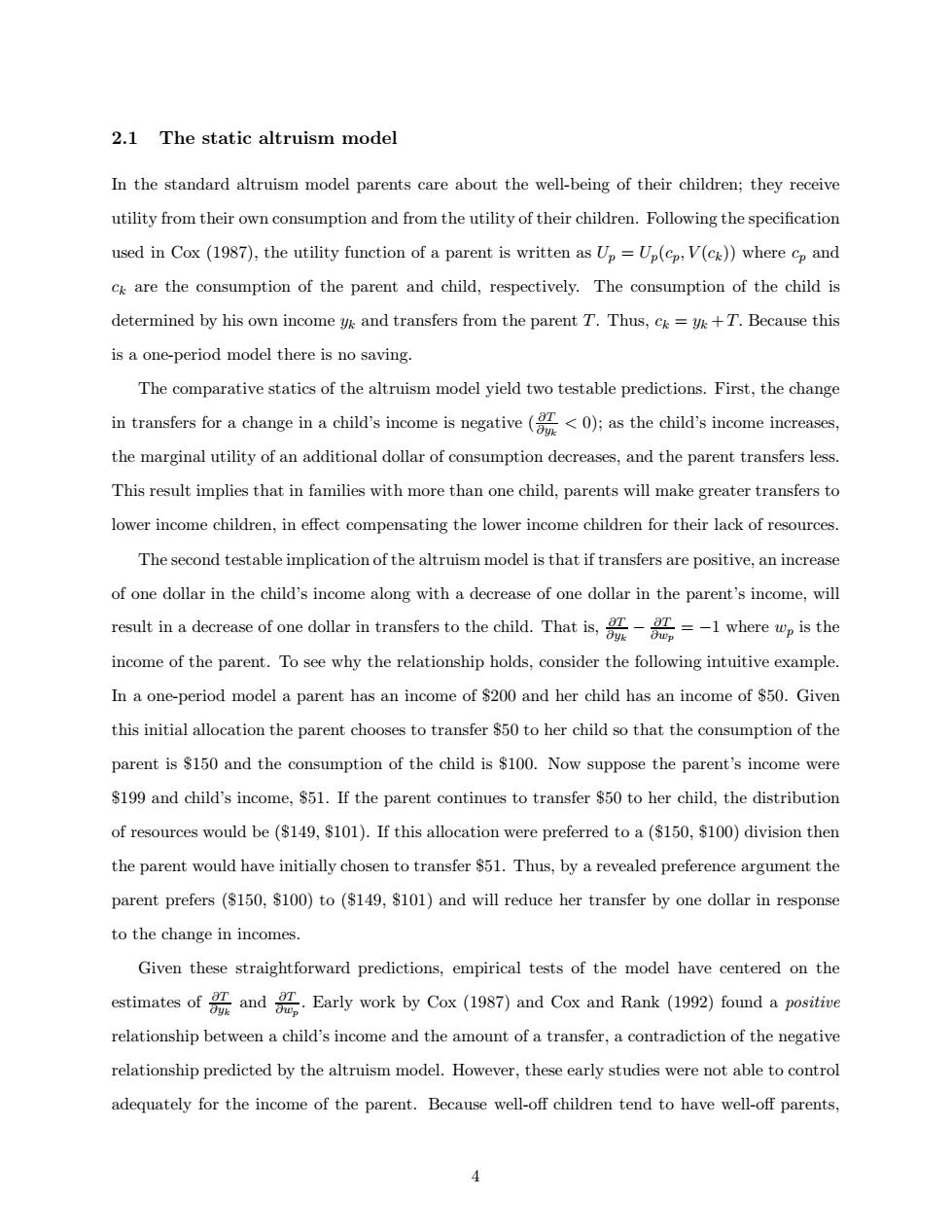正在加载图片...

2.1 The static altruism model In the standard altruism model parents care about the well-being of their children;they receive utility from their own consumption and from the utility of their children.Following the specification used in Cox(1987),the utility function of a parent is written as Up=Up(cp,V(ck))where cp and ck are the consumption of the parent and child,respectively.The consumption of the child is determined by his own income y and transfers from the parent T.Thus,ck=yk+T.Because this is a one-period model there is no saving. The comparative statics of the altruism model yield two testable predictions.First,the change in transfers for a change in a child's income is negative();as the child's income increases, the marginal utility of an additional dollar of consumption decreases,and the parent transfers less. This result implies that in families with more than one child,parents will make greater transfers to lower income children,in effect compensating the lower income children for their lack of resources. The second testable implication of the altruism model is that if transfers are positive,an increase of one dollar in the child's income along with a decrease of one dollar in the parent's income,will result in a decrease of one dollar in transfers to the child.That is,1where is the income of the parent.To see why the relationship holds,consider the following intuitive example. In a one-period model a parent has an income of $200 and her child has an income of $50.Given this initial allocation the parent chooses to transfer $50 to her child so that the consumption of the parent is $150 and the consumption of the child is $100.Now suppose the parent's income were $199 and child's income,$51.If the parent continues to transfer $50 to her child,the distribution of resources would be ($149,$101).If this allocation were preferred to a($150,$100)division then the parent would have initially chosen to transfer $51.Thus,by a revealed preference argument the parent prefers ($150,$100)to ($149,$101)and will reduce her transfer by one dollar in response to the change in incomes. Given these straightforward predictions,empirical tests of the model have centered on the estimates of andEarly work by Cox (1987)and Cox and Rank (192)found a positive relationship between a child's income and the amount of a transfer,a contradiction of the negative relationship predicted by the altruism model.However,these early studies were not able to control adequately for the income of the parent.Because well-off children tend to have well-off parents, 42.1 The static altruism model In the standard altruism model parents care about the well-being of their children; they receive utility from their own consumption and from the utility of their children. Following the specification used in Cox (1987), the utility function of a parent is written as Up = Up(cp, V (ck)) where cp and ck are the consumption of the parent and child, respectively. The consumption of the child is determined by his own income yk and transfers from the parent T. Thus, ck = yk +T. Because this is a one-period model there is no saving. The comparative statics of the altruism model yield two testable predictions. First, the change in transfers for a change in a child’s income is negative ( ∂T ∂yk < 0); as the child’s income increases, the marginal utility of an additional dollar of consumption decreases, and the parent transfers less. This result implies that in families with more than one child, parents will make greater transfers to lower income children, in effect compensating the lower income children for their lack of resources. The second testable implication of the altruism model is that if transfers are positive, an increase of one dollar in the child’s income along with a decrease of one dollar in the parent’s income, will result in a decrease of one dollar in transfers to the child. That is, ∂T ∂yk − ∂T ∂wp = −1 where wp is the income of the parent. To see why the relationship holds, consider the following intuitive example. In a one-period model a parent has an income of $200 and her child has an income of $50. Given this initial allocation the parent chooses to transfer $50 to her child so that the consumption of the parent is $150 and the consumption of the child is $100. Now suppose the parent’s income were $199 and child’s income, $51. If the parent continues to transfer $50 to her child, the distribution of resources would be ($149, $101). If this allocation were preferred to a ($150, $100) division then the parent would have initially chosen to transfer $51. Thus, by a revealed preference argument the parent prefers ($150, $100) to ($149, $101) and will reduce her transfer by one dollar in response to the change in incomes. Given these straightforward predictions, empirical tests of the model have centered on the estimates of ∂T ∂yk and ∂T ∂wp . Early work by Cox (1987) and Cox and Rank (1992) found a positive relationship between a child’s income and the amount of a transfer, a contradiction of the negative relationship predicted by the altruism model. However, these early studies were not able to control adequately for the income of the parent. Because well-off children tend to have well-off parents, 4